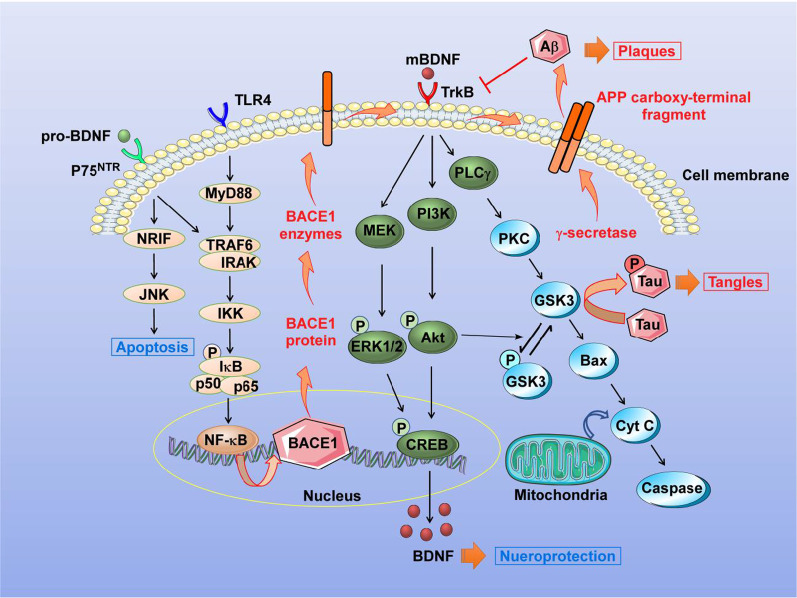Fig. 2.
BDNF-related signaling pathways in AD. The pathways related to neuronal excitability are triggered by the interaction between BDNF and TrkB, inducing its dimerization and autophosphorylation of tyrosine residues in the cytoplasmic kinase domain. MEK, PI3K and PLCγ signaling pathways are activated to phosphorylate the transcription factor CREB that mediates transcription of genes essential for synaptic plasticity. GSK3 becomes inactive after phosphorylation, resulting in synthesis of glycogen in the liver cells. When GSK3 remains in its active form, it hyper-phosphorylates tau protein in nerve cells, resulting in the microtubule destabilization and neurofibrillary tangle formation and finally leads to AD. GSK3 also induces the overexpression of Bax to mediate apoptotic injury. Additionally, interaction between pro-BDNF and p75NTR induces apoptosis through the JNK cascade. The activated NF-κB promotes the expression of β-secretase 1 (BACE1) gene, followed by the overexpression of BACE1 protein and enhanced BACE1 enzyme activity. Aβ is generated from APP by two enzymes: β-secretase (BACE1 is the major one) cuts APP first to produce a C-terminal fragments (CTFs), including C89 and C99. C99 is a membrane bound product. Then γ-secretase (including presenilin, nicastrin, APH-1 and PEN-2) cleaves C99 at a position inside the cell membrane to generate the mature Aβ peptide. In turn, Aβ inhibits the expression of TrkB, leading to neurodegeneration. BDNF: brain-derived neurotrophic factor, p75NTR: p75 neurotrophin receptor, TrkB: tropomyosin receptor kinase B, Aβ: amyloid β, APP: amyloid β precursor protein, BACE1: β-secretase 1; NRIF: NT receptor interacting factor, JNK: c-Jun N-terminal kinase, TRAF6: TNF receptor associated factor 6, IRAK: Interleukin-1 receptor-associated kinase, IKK: inhibitor of nuclear factor kappa-B kinase, IκB: inhibitor of NF-κB, NF-κB: nuclear factor-κB, TLR4: Toll-like receptor 4, MyD88; Myeloid differentiation primary response gene 88, TNF-α: tumor necrosis factor-α, MEK: mitogen-activated protein kinase kinase, ERK1/2: extracellular signal-regulated protein kinase 1/2, CREB: cAMP-response element binding protein, PI3K: phosphoinositide 3-kinase, Akt: protein kinase B, PLCγ: phospholipase Cγ, PKC: protein kinase C, GSK3β: glycogen synthase kinase-3β, Cyt C: cytocheome C

